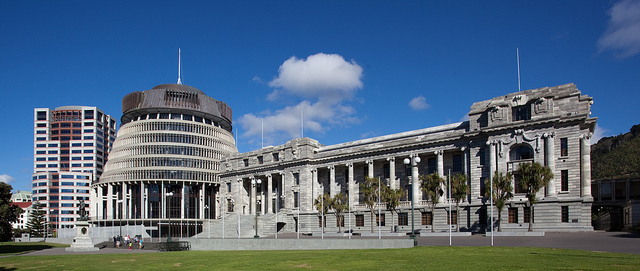What will the long term impact of the Cabinet Manual be? Developments in New Zealand may hold the answer
Gordon Brown introduced the Cabinet Manual in 2011 in advance of what looked set to be a coalition or minority government in order to clarify the operation of government at a time when conventions and unwritten rules looked to be insufficient. The Cabinet Secretary at the time, Gus O’Donnell, who drew the document up, took inspiration from New Zealand – a country with similar politics and which also lacks a formal written constitution. Here, Grant Duncan describes the evolution of New Zealand politics since their cabinet manual came into force.
In early 2010, anticipating a hung parliament, Gordon Brown, then Prime Minister, announced the drafting of a Cabinet Manual. This was intended to document and clarify the conventions of caretaker government and government formation. Given the timing, though, this announcement was politically sensitive. Drafts were scrutinized and questions asked by committees of both Houses. Should the Manual be regularly debated or approved by Parliament? Was this the first step towards a written constitution? Would the Manual steal in a biased interpretation of constitutional conventions, or undermine centuries of tradition? Would it have a constraining effect on ministerial actions and be used as grounds for judicial review?
The draft drew on the example of the New Zealand Cabinet Manual. Like the UK, New Zealand lacks a written constitution; it has inherited – and adapted – Westminster conventions. In contrast to the UK, New Zealand’s Cabinet Manual evolved gradually. The first edition, in 1979, brought together existing procedures and conventions of Cabinet. It was a restricted document, issued in numbered copies only. Even backbench MPs were denied access. But in 1991 it became available to all public servants; then in 1996 it was published as a bound volume for sale. It appeared on-line in 1998.
Its introduction (by Sir Kenneth Keith) outlines the sources of New Zealand’s constitution; other chapters describe constitutional conventions and a code of conduct for cabinet and for ministers. Although it is often cited in question-time in the House of Representatives, it has never been tabled for debate or select-committee inquiry. It has no statutory authority, but is treated as ‘authoritative’ for practical purposes. Successive Prime Ministers of both major political parties have endorsed the Manual at their first cabinet meeting; so there is cross-party consensus supporting its existence and contents. I argue that the adoption of the Manual by a new government has itself become a constitutional convention in Wellington.
In 1996, New Zealand’s electoral system switched from first-past-the-post to the German model of mixed-member proportional (MMP). Elections are now unlikely to result in a single-party majority. With a three-year term, there have so far been seven MMP elections. These have produced diverse governing arrangements. A leading party, National or Labour, with a minority of seats, may use confidence-and-supply agreements with minor parties (who hold portfolios outside cabinet); or, less frequently in recent terms, formal coalitions with shared seats in cabinet. Government-formation has sometimes been a lengthy process. In 1996 it took nine weeks from the election to swear in the new government. Even when it’s clear there will be no change of government (such as after the 2014 election), the process of negotiating and drafting agreements with minor parties may take two weeks. The caretaker conventions have thus been thoroughly tested, with no major constitutional crises.
There is debate in the UK over whether the Cabinet Manual should state that, following an election, the incumbent PM has a duty not to resign until it is clear who will form the incoming government. The NZ Cabinet Manual is non-committal about this. It states descriptively that ‘Ministers usually remain in office in a caretaker capacity until the new government is sworn in.’ The PM advises the Governor-General (the Queen’s representative) to accept the resignations of ministers (including him/herself) only at that time. This ensures that the Sovereign never lacks responsible advisers. In keeping with the NZ Cabinet Manual’s self-styled role as only a record of convention, and not a set of prescriptions, it does not assert that the PM has any positive duty to remain in office until the swearing-in. It only states that this is what ‘usually’ happens (para. 6.43), and not even ‘by convention’. A defeated caretaker PM would tarnish his or her legacy to resign earlier without a compelling reason – but would not be in breach of the Cabinet Manual.
The shift to MMP and the writing of constitutional conventions into the Cabinet Manual did not change the conventions of government-formation in Wellington. There were hung parliaments in the past (notably 1928), and one mid-term change of government (1912). MMP changed the political landscape, but the pre-existing conventions have sufficed. The formation of a government is negotiated by the elected members; Governors-General do not get mired in these political processes. The Cabinet Manual now clarifies the respective roles of the actors concerned; this is helpful for political commentators and the public at large.
Where the Cabinet Manual has had a role in changing convention is around cabinet collective responsibility. This convention was adapted by Helen Clark (PM, 1999–2008). The Manual reasserts the principle of cabinet unanimity, but now includes two important exceptions (see paragraphs 5.22–27). In a formal coalition between two parties, there is an agree-to-disagree provision. This means that the minor party can publicly state that it differs from the government on a particular policy. Its ministers are still responsible for their roles in implementing the policy, but, if the party needs to differentiate itself politically, they can state their differing position without being sacked from the cabinet.
Further, where a minority government is supported by a smaller party on confidence and supply votes, one or more members from that support-party may be rewarded with ministerial portfolios outside of cabinet. Thus they are only bound by collective responsibility ‘in relation to their particular portfolios’. It is not uncommon therefore to hear a minister who is a member of a minor supporting party disagree with government on a policy or vote against a government bill not related to his/her portfolio.
The relative ease with which the Cabinet Manual can be revised, with the PM’s approval, as political and legal conditions change, enables it to reflect, and indeed to facilitate, the evolution of constitutional conventions in New Zealand. But has New Zealand violated an ancient convention by putting into writing that very aspect of Westminster constitutions that was supposed to be ‘unwritten’? How can the Cabinet and its secretariat have the audacity to interpret the Sovereign’s reserve powers and how they may be used? Could a future Governor-General, faced with a political deadlock, find it difficult to take an action that’s ‘not in the Manual’? For example, the NZ Cabinet Manual is silent on possible circumstances where a Governor-General may refuse a PM’s request to dissolve parliament and call an early election. (The prerogative power to dissolve parliament still applies in NZ.)
While the NZ courts have referred to the Cabinet Manual occasionally for contextual information, none of its ‘authoritative’ and ‘descriptive’ statements has yet formed the basis for a successful judicial review of executive decision-making. But, as the Cabinet Manual becomes more widely cited in the heat of political debates, could it unintentionally acquire authority that begins to be ‘law-like’?
—
Note: this post represents the views of the author, and not those of Democratic Audit or the LSE. Please read our comments policy before posting.
—
 Grant Duncan is is Associate Professor in the School of People, Environment, and Planning at Massey University, New Zealand. His academic profile can be found here.
Grant Duncan is is Associate Professor in the School of People, Environment, and Planning at Massey University, New Zealand. His academic profile can be found here.






 Democratic Audit's core funding is provided by the Joseph Rowntree Charitable Trust. Additional funding is provided by the London School of Economics.
Democratic Audit's core funding is provided by the Joseph Rowntree Charitable Trust. Additional funding is provided by the London School of Economics.
What will the long term impact of the Cabinet Manual be? Developments in New Zealand may hold the answer https://t.co/i1p4TAPgky
What will the long term impact of the Cabinet Manual be? Developments in New Zealand may hold the answer https://t.co/GabDJ0nmRL
What will the long term impact of the Cabinet Manual be? Developments in New Zealand may hold the answer https://t.co/TQP0gnpFqq
What will long term impact of the Cabinet Manual be? Developments in #NZ may hold the answer, writes Grant Duncan https://t.co/1xZr3kK6yg
What will the long term impact of the Cabinet Manual be? Developments in New Zealand may hold the answer https://t.co/Z0I6obKCd4
What will the long term impact of the Cabinet Manual be? Developments in New Zealand may… https://t.co/ELXbPLmnD2 https://t.co/YBdPl8so8S